By Narasim Katary
The crossing over of Oryst Sawchuk leaves a large void in the social fabric of Sudbury. The multi-talented, multi-contributor was a Community Builder in the truest sense of the expression. This is a good time to recapitulate his contributions in order to appreciate the dimensions of the void he has left behind.
Sawchuk was a professional architect by training. In addition, he was also an artist, a musician, a businessperson, and a contributor to community advancement through his indefatigable volunteer work with the Sudbury Chamber of Commerce, the Art Gallery of Sudbury, and the Sudbury Arts Council.
His lasting legacy to the City of Greater Sudbury and beyond includes the following major achievements.
As an architect, he designed several landmark buildings and some are considered by his peers as making a statement to both reflect and project the built form of Sudbury in a creative fashion.
Three signature buildings that have influenced the physical form are worth mentioning. They are: the Grace Hartman Amphitheatre, the Sudbury Transit Centre, and the Lo-Ellen Park Secondary School. It hardly needs mentioning that the Greek-style Amphitheatre inspired a group of young people to start the longest running bilingual music festival, the Northern Lights Festival Boreal a few years later.
The Sudbury Transit Centre is a landmark design that evokes the soaring spirit of Sudbury, a hardy spirit that has withstood the roller coaster rides of the principal industry.
As an artist, he captured Sudbury’s heritage in pen/ink and watercolour paintings that have been displayed numerous times at the Art Gallery of Sudbury. His initiative in the mid-1990s led to creation of The Acorn Gallery of Oak, one of the premier private galleries in the city. His love of art made him invite young people to come and share in the excitement of imagining original work. He created the original logo for the Sudbury Theatre Centre.
As a musician, he played in community bands dating back to the 1940s and was the conductor of the Jubilee Folk Ensemble that was established more than 25 years ago. Many in the community have experienced the enjoyable performances by the Ensemble during important events in the city.
His volunteer work is too numerous to mention them all here. The following examples are indicative.
As a member of the Chamber of Commerce, he was instrumental in installing the Spirit of 86 sculpture public art adjacent to the Sudbury Theatre Centre. He was the president of the Association of United Ukrainian Canadians, Sudbury Branch, for more than a decade and worked tirelessly to reinforce the Canadian Mosaic in all its multifarious dimensions.
His love of diversity never hindered his love for Canada as an exceptional country that sees the whole emerging out of the many. His volunteer work with the Art Gallery of Sudbury, the Sudbury Theatre Centre, the City’s Heritage Advisory Committee and the Archives Committee are well known.
All his activities mentioned above and the others not mentioned are informed by a clear vision he had that he shared with others in the city. For the 35 years that I knew him, he consistently held the view that Sudbury ought to emerge as the economic/cultural/intellectual capital of Northern Ontario.
All his contributions attempted to reach that goal in his field of specialization, namely, art. That the goal is not yet fully realized is simply a matter of the vagaries of urban development beyond the grasp of any one individual, however accomplished he may be. That Oryst Sawchuk will be remembered as a visionary who worked diligently to reach the goal cannot be disputed.
Sawchuk exemplifies the idea that the greatest satisfactions in life come when one works for something larger than self. It is therefore only appropriate that our community remember him for his notable contributions.
Taking solace from religion and science, we need to celebrate him. I do not view his crossing over as an end, but as the latest transformation – from one state to another. The 1662 version of the English Book of Common Prayer adapts from Genesis 3:1 (c. 1450 to 1400 BCE), and recommends that the presiding priest at a burial say, “… We therefore commit his body to the ground; earth to earth, ashes to ashes, dust to dust; in sure and certain hope of the Resurrection to eternal life …”.
The profound truth embedded in the Book of Common Prayer is validated by contemporary advances in particle physics. One of the deep laws of our universe is that nothing is created or destroyed. Everything is merely transformed. A New Physics Theory of Life by Jeremy England of MIT, summarized in Quanta Magazine (2014 January 22) is the latest formulation of the concept.
I therefore, invite you to join in celebration of Oryst and his contributions.
A rotating stable of community members share their thoughts on anything and everything, the only criteria being that it be thought-provoking.
Got something on your mind to share with readers in Greater Sudbury? Climb aboard our Soapbox and have your say. Send material or pitches to [email protected].
